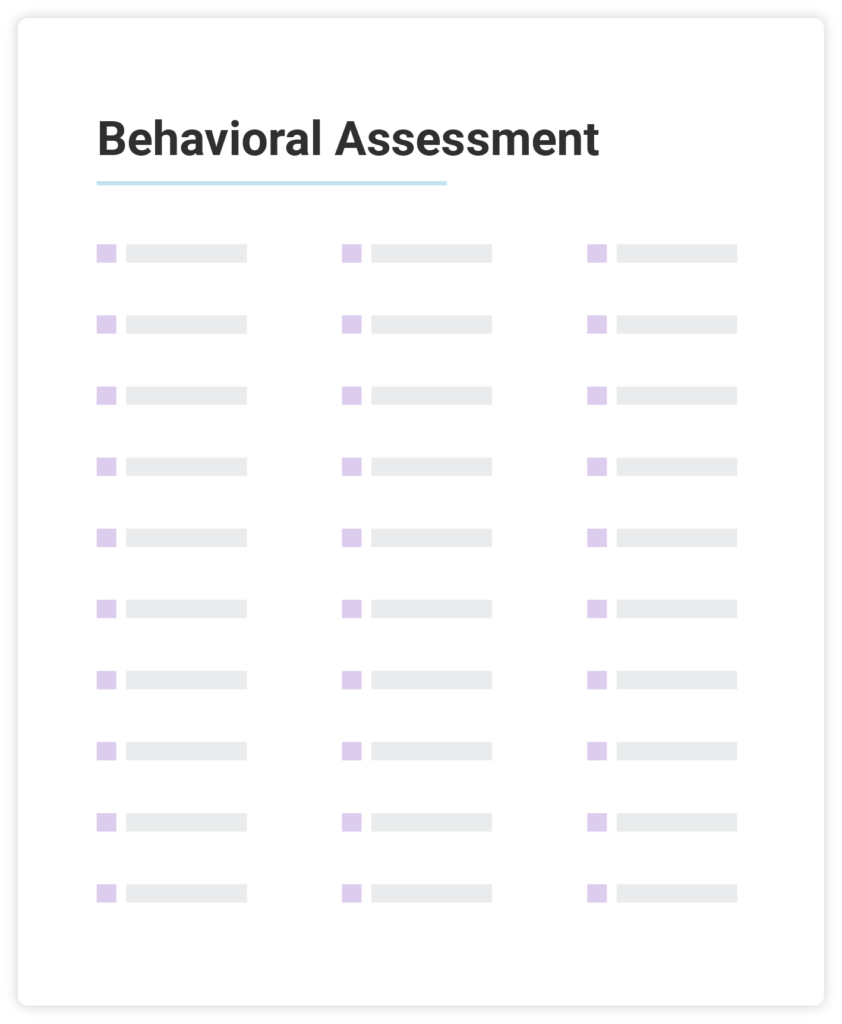Introduction to the PI Behavioral Assessment
What is the PI Behavioral Assessment?
The PI Behavioral Assessment (“BA”) is a self-report measure of adult work-related personality based on prominent theories of workplace behavior. It has been developed and validated extensively and exclusively for use in the workplace. The BA is untimed, takes an average of six minutes to complete, and is available through an easy-to-use online format.

The assessment uses a free-choice response format: Participants are presented with two questions, each followed by a list of adjectives. The first question asks participants to select adjectives that they feel describe the way they are expected to act by others (Self-Concept). The second question asks respondents to select adjectives that they feel actually describe them (Self).
Each of the adjectives on the PI Behavioral Assessment is associated with one of five factors: Dominance, Extraversion, Patience, Formality, and Objectivity (referred to as Factors A, B, C, D, and E respectively). Dominance, Extraversion, Patience, and Formality are primary factors that determine the participants’ preferred behavioral drives in the workplace. Objectivity is used as a secondary factor describing a participant’s decision-making style in the expression of the four primary factors. Scores are presented graphically as Behavioral Patterns. The patterns are then interpreted by trained PI practitioners, who utilize the BA data for hiring, coaching, motivation, and development of employees.


Dominance
The degree to which an individual seeks to control their environment.

Extraversion
The degree to which an individual seeks social interaction with other people.

Patience
The degree to which an individual seeks consistency and stability in their environment.

Formality
The degree to which an individual seeks to conform to formal rules and structure.

Objectivity
The degree to which an individual relies on objectivity when processing information and making decisions.
Additional resources:
- Learn more about the history of the BA.
- Learn more about the validity, reliability and fairness of the BA.
How is the BA scored and interpreted?
The BA is a free-choice assessment. Aside from a minimum requirement of six selections, respondents can choose as many or as few of the provided adjectives as they’d like. It’s important to note that there are no “good” or “bad” BA scores, as they’re not meant for comparison between people. Instead, BA scores represent relative differences within people. The focus is not on how one’s personality compares someone else, but instead on the relative degree to which this person expresses different behavioral factors.
While each factor is scored independently, the best way to anticipate someone’s workplace behavior based on their assessment responses is by viewing their overall Behavioral Pattern. What is the respondent’s highest factor? What is their lowest factor? That combination can be used to determine likely work-related behaviors.
The width of a pattern can also be meaningful. Wider patterns tend to be more clearly and consistently expressed (in other words, the volume is turned up at extremes of the scale). Scores closer to the midpoint (which we call “situational”) represent more adaptable drives; the respondent may have an easier time adjusting behavior for that factor as needed, but does not strongly express the factor either way.
Tips when administering the BA
When administering the Behavioral Assessment, it’s important to keep several best practices in mind. Here are a few tips to promote fairness and ensure accurate results:
- The recipient should take the assessment in their preferred language whenever possible.
- Introduce the assessment in a casual, non-confrontational manner.
- The assessment requires the recipient’s own responses and should be influenced as little as possible by the administrator, other people, and the environment.
- When administering the assessment to a group, instruct recipients not to discuss the assessment while completing it.
Recipients may be unsure of how the results will be interpreted or used. They may also be nervous to participate or uninterested in doing so. To help set expectations, advise the recipient:
- There are no right or wrong answers—it’s not a test.
- Read instructions carefully and use your own judgment to answer questions. If you do not understand a particular word, skip it.
- The assessment should have your full concentration, so limit or remove any possible distractions.
- Time is not a factor; take as much time as you need.
What are Reference Profiles?
The 17 Reference Profiles are distinct groupings of Behavioral Patterns that help assessment takers understand their specific BA results in “reference” to other people. If your Behavioral Pattern is your home address, think of your Reference Profile as your zip code.
Each Reference Profile has a prototypical Behavioral Pattern. The distance between a BA respondent’s factor scores and those of each of the 17 Reference Profile plot points is calculated, and the Reference Profile with the shortest distance is selected. (There is a bit more to it than that, in that we have to “stretch” the profiles to put them on the same plane and calculate the distance using Euclidean distance. We recommend visiting the Science Behind Reference Profiles for more information.)
How is the BA used in practice?
Hiring
The BA is valid for use in making hiring decisions. Hiring managers can set a “Behavioral Target” in PI Hire through a guided process to answer the question: What does the Behavioral Pattern of a strong performer look like for this job? Candidate results are compared to the Job Target via a “fit rating,” which gauges an individual’s behavioral fit. Our software also produces a unique interview guide for each candidate to tap into their potential strengths and areas of opportunity based on their BA results.
Development
Training plans can be created based on an individual’s BA factor pattern. We recommend looking at factor differences rather than the Reference Profile, as the differences will provide better insights as to the development needs of the individual. The Personal Development Guide, available in PI Inspire, provides a great starting point to developing individualized training plans.
Change Management
Practitioners advise leaders managing change at a company by helping them understand how their employees’ behavioral drives might impact their readiness for a change, their reactions to the change, and their desire to be engaged with the change process.
Growth Strategy
Practitioners also use the results of the PI Behavioral Assessment to consider how behavioral drives and needs play a role in training employees and leveraging their awareness of their behavioral drives to help them succeed in new roles.
What else should I keep in mind when administering the BA?
Device
Participants are free to use computers, tablets, or mobile phones to take the PI Behavioral Assessment online. Based on our research, the choice of device has no impact on the accuracy of someone’s scores or Behavioral Pattern. Participants should use whichever device they feel most comfortable with.
Respondent Age
There are no restrictions on how old a respondent must be to take the BA, but since it’s been developed and validated only with working adult samples (age 18 and older), clients should exercise extreme caution when using or interpreting results collected from minors (e.g., high school students).
Has the BA been reviewed by third parties?
Our Science Team is responsible for developing, maintaining, monitoring, and documenting PI’s assessments to ensure that they are valid, reliable, and fair. The PI Behavioral Assessment has been in widespread commercial use since 1955, and the validity and reliability of the BA have been investigated by numerous PI researchers and third parties.
The most comprehensive third-party review of the BA was conducted from 2017 to 2018 through the certification company DNV-GL. In that review, the BA was reviewed by two psychologists and independent auditors who evaluated the assessment against the guidelines published by the European Federation of Psychologists’ Associations (EFPA, 2013). This audit covered validity, reliability, fairness, development, norms, reporting, supporting documentation and training, and even pricing and distribution. The PI Behavioral Assessment passed this review and was certified under the EFPA model in September 2018. The submission in 2018 additionally included region specific evidence and achieved certification for use specifically in Norway and Sweden. PI continues to maintain this certification through periodic reviews and most recently earned their re-certification with the EFPA in 2021.
To inform us of a typo or other error, click here. To request a new feature, click here.